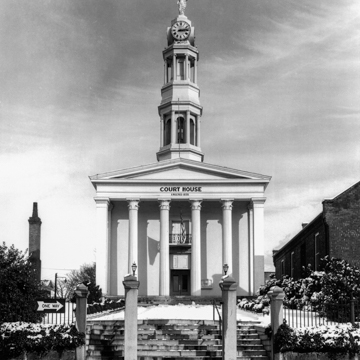High on a hill overlooking the city's commercial area, the Petersburg Courthouse is a temple-form building that symbolizes Petersburg's urban aspirations in the antebellum era. Designed by one of New York City's leading classical architects, the courthouse draws on William and Henry Inwood's St. Pancras Church (1822) in London in its five-bay pedimented front portico and soaring octagonal bell tower, though here the order is Corinthian rather than Ionic as at St. Pancras. Dominating the skyline, this multitiered tower provided a convenient sighting mark for Union artillery fire during the ten-month Siege of Petersburg and thus was saved from destruction. Although the exterior of the courthouse managed to survive in remarkably good condition, much of its interior has succumbed to remodeling. Fortunately, the fine coffered, domed ceiling of the large second-floor courtroom remains intact.
The courthouse's brick walls, stuccoed and scored to resemble ashlar, contrast with the adjacent one-story red brick Clerk's Offices (1850s; 1899, Bartholomew F. Smith) joined together in the right forecourt. These small offices with parapeted elbow gables would be at home in any of Virginia's rural courthouse squares. The 1899 Clerk's Office is an example of the fire- and theft-proof structures for which Smith was noted. A modern interpretation of these offices, the Circuit Court and Clerk's Office (1996, Bond Comet Westmoreland and Hiner) stands on the opposite side of the forecourt.








